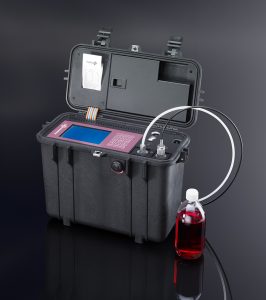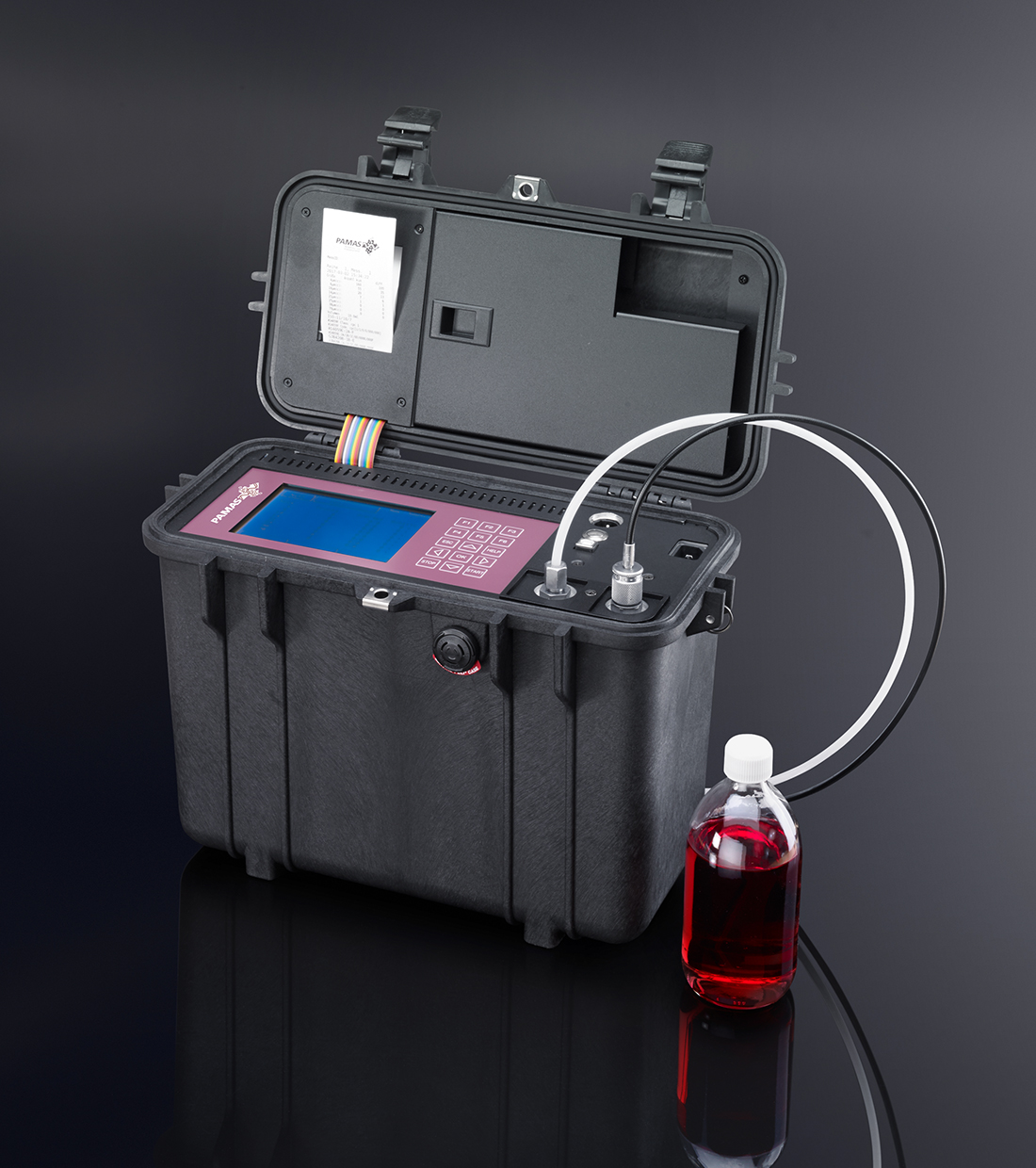Laser-optical particle counting compared to pore blocking technique
 Fluid contamination can be measured by various analytical methods. In this article we compare the laser optical method (light blocking, light extinction) with “pore blockage”.
Fluid contamination can be measured by various analytical methods. In this article we compare the laser optical method (light blocking, light extinction) with “pore blockage”.
How does the Light Extinction method work?
The illumination source is a laser diode. The laser beam is collimated by a lens array and shaped into a straight and flat beam that is focused on the optical measuring window of the measuring cell. The beam passes through the measuring cell and leaves it through a second optical window, after which it is projected onto a photodiode. The photodiode thus measures the light intensity behind the contaminated fluid flow. The photodiode delivers a current as an output signal that is proportional to the intensity of the light it receives. Each individual particle that flows through the measuring cell causes a current change on the photodiode. The sensor electronics evaluate this current change as a particle signal. The shadow area on the photodiode represents the size of the particle.
A light extinction particle counter counts and measures particles of different sizes. Each individual particle in the liquid is detected and assigned to a channel with a specific size. After the measurement, the measurement results are reported as particle counts for the individual size channels. When reporting the results according to cleanliness class standard, the measurement results are displayed in simplified form, either in 6 size classes between 4 and 70 µm(c) (according to SAE AS 4059 AF) or in 5 size classes between 6 and 70 µm(c) (according to SAE AS 4059 BF). The triple code according to the ISO 4406 standard reports three channel sizes of 4, 6 and 14 µm(c). The optical PAMAS particle counters exceed the requirements of general cleanliness standards and provide a detailed particle size distribution for up to 32 particle size channels.
How does the pore blocking technique work?
In this filter blocking technique, the sample fluid is passed through a membrane with a defined pore size (e.g. 10 µm). Particle sizes exceeding the pore size are separated and trapped on the surface of the membrane, so over time the pores of the membrane filter are blocked by particles.
Two different variants of the pore blocking technique can be applied:
- If the flow rate is kept stable, the increase in differential pressure can be measured.
- Conversely, the flow rate reduction can be determined if the pressure drop is kept at a constant level.
At constant flow rate, a pressure increase can be observed during the measurement. This is because the open pores on the membrane become clogged. Due to the reduction in the number of pores, the sample flow is increasingly blocked and the pressure difference increases. At constant pressure, the conditions are reversed: the flow rate gradually decreases while the filter becomes increasingly clogged. Using a manufacturer-specific mathematical formula, the measurement data are then converted into corresponding cleanliness classes.
Compared to counting particles with the light extinction method, the pore blocking technique has one advantage: the measurement result is hardly affected by the presence of air bubbles or free water. However, the measurement result can be affected by insoluble additives that stick in the filter.
Furthermore, the filter blocking method is only semi-quantitative because it provides information about the entire degree of contamination, while the number and size of individual contaminants is not measured. Measurement of individual particles and accurate knowledge about the particle size distribution can only be obtained by means of the light extinction technique. The pore blocking method is also limited to a few particle sizes. Particles smaller than the pore size cannot be detected. This filter blocking technique can also be influenced by the fluid viscosity: differences in viscosity can affect the differential pressure at constant flow rate. This leads to erroneous measurement results. If changes in fluid viscosity occur, the pore blocking method can only be applied at constant pressure and variable flow rate (by measuring the differential flow rate). Furthermore, the pore blocking method does not detect fluid contamination (e.g. oil contamination in hydraulic systems carrying water-glycol) and thus misleads the user into believing that his system is actually clean.

Conclusion
While the pore blocking technique only allows a rough indication of contamination, light extinction sensors measure the size of each individual particle in the sample fluid. The pore blocking technique does not measure individual particles, but only calculates the pressure difference related to a specific particle size.
The pore blocking technique may not report particle measurement results according to cleanliness standards. A standardized report of contamination results according to SAE AS 4059 can ONLY be achieved with an optical particle counter, calibrated according to ISO 11171.
Accurate information on the size and number of individual contaminants is an indispensable requirement in many applications. The light extinction method is the only suitable method for this.
www.pamas.de